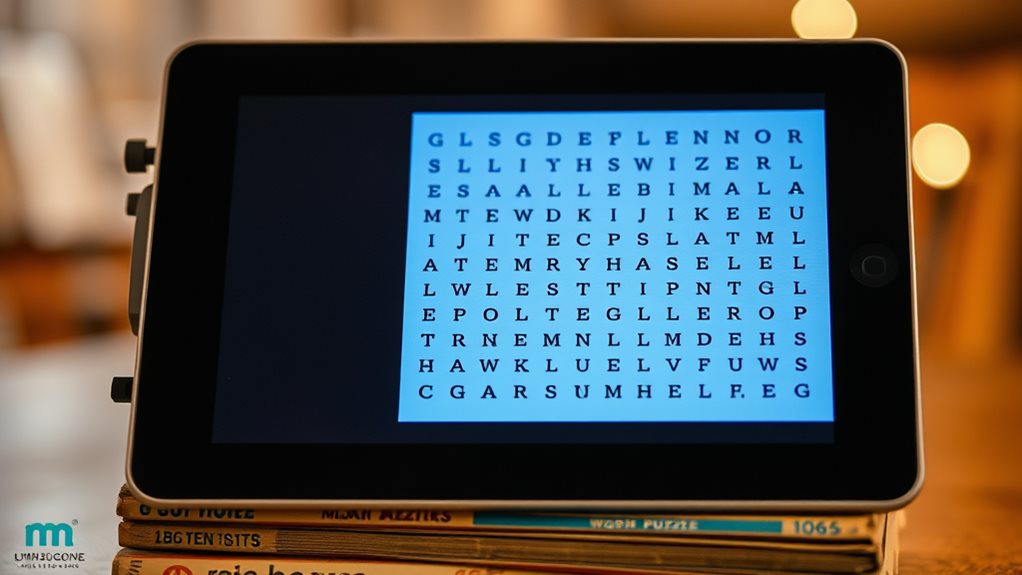
Word search puzzles, as they are understood today, originated in 1968 when Norman E. Gibat published the first modern version in Selenby Digest. The inaugural puzzle, titled “Word-Cross Puzzle,” measured 8.5 by 5.5 inches and quickly gained popularity due to its simple yet engaging format. Earlier contributions from Pedro Ocón de Oro and James Patrick Carr helped shape the puzzle’s development, while the digital age transformed these puzzles through online platforms and mobile gaming. Word searches have evolved from simple printed grids to sophisticated educational tools, generating significant economic opportunities for creators. The fascinating journey of word search puzzles reveals much more about their impact on education, technology, and modern gaming culture.
Key Takeaways
- Word search puzzles were first published in 1968 by Norman E. Gibat in Selenby Digest, featuring an 8.5 by 5.5-inch “Word-Cross Puzzle.”
- Early pioneers like Pedro Ocón de Oro and James Patrick Carr contributed to developing word searches from observational puzzles.
- The puzzles’ simple format and adaptable nature led to their rapid global popularity and widespread educational adoption.
- Digital transformation in the 1970s and 1980s brought word searches to computers and TV screens, revolutionizing accessibility.
- Word searches evolved from print media to digital platforms, introducing interactive features, multiplayer modes, and customization options.
The Birth of a Classic

Norman E. Gibat created the first documented word search puzzle, which appeared in the Selenby Digest, a small want-ad publication in Norman, Oklahoma, in 1968. The original puzzle, titled “Word-Cross Puzzle,” was published on a standard page measuring 8.5 by 5.5 inches, establishing the foundation for a format that would become globally recognized.
However, the origins of word search puzzles remain a subject of scholarly debate within the puzzle community. Some historians point to earlier contributions by Pedro Ocón de Oro, who published similar puzzles called “Sopas de letras” in Spanish, while others credit James Patrick Carr with developing comparable formats before Gibat’s publication. These competing claims have led to ongoing discussions about the true originator of the word search concept.
The puzzle’s design may have evolved from observational puzzles, but its simplicity and adaptable nature quickly captured public interest. Word searches proved particularly valuable in educational settings, where teachers recognized their potential for teaching vocabulary, spelling and various subject matter, leading to widespread adoption in classrooms and publications worldwide. Their success was partly due to being inexpensive to create while providing significant educational value.

Following the initial success of word search puzzle books in print, educators began recognizing their remarkable potential as teaching tools. These puzzles proved to be effective instruments for developing vital educational skills, including vocabulary expansion, spelling improvement, and enhanced pattern recognition abilities.
The puzzles’ educational impact extends beyond basic literacy, as they contribute substantially to cognitive development and academic performance. Students who regularly engage with word searches demonstrate improved verbal reasoning, stronger working memory and enhanced processing speed, which are essential for academic achievement. These engaging activities blend learning and fun, making them particularly effective for children’s educational development. And in addition, these puzzles help develop test-taking skills through the reinforcement of vocabulary, problem-solving and memory retention.
Research has shown that word search puzzles offer substantial psychological benefits, fostering persistence and building self-esteem through successful completion. The long-term cognitive effects are equally remarkable, with studies indicating that regular engagement with word puzzles correlates with better cognitive function throughout life. These puzzles also serve as valuable tools for maintaining mental acuity, particularly in adults over 50, and contribute to lifelong learning and knowledge retention.
Digital Gaming Revolution

The digital age ushered in a transformative era for word search puzzles, as they evolved from their print origins to dynamic digital platforms. Early adaptations emerged in the 1970s and 1980s for computers and television screens, while online tools later revolutionized puzzle creation and distribution.
The rise of digital gaming platforms substantially influenced word search development, with games like Words with Friends in 2009 popularizing online multiplayer capabilities. Digital versions introduced customization options, thousands of levels, and innovative gaming mechanics, including power-ups and themed variations that expanded the traditional format. Today, these puzzles are 100% free online and accessible to players worldwide.
This digital transformation enhanced both creation and accessibility, allowing puzzle makers to develop more complex and varied word searches while reaching broader audiences. Online communities emerged, connecting enthusiasts globally and fostering a rich network of players and creators.
Looking ahead, word search puzzles continue to evolve through technological advancement, incorporating AI-generated content and augmented reality experiences. Mobile gaming platforms have particularly impacted accessibility, with successful applications like Wordle demonstrating the enduring appeal of digital word games and their potential for future innovation.
Marketing Magic and Money

With strategic marketing and innovative monetization approaches, word search puzzles have evolved into a lucrative business opportunity for creators and publishers alike. Publishers can leverage AI-assisted tools for puzzle creation, utilize platforms like Canva for design, and distribute through Amazon Kindle Direct Publishing to tap into this growing market. The Print-on-Demand feature eliminates the need for inventory management and shipping logistics, making it an attractive business model.
The economic potential of word search puzzles is significant, with successful creators earning upwards of $5,000 monthly through targeted marketing strategies and continuous optimization. Publishers can expand their reach by developing themed collections, implementing keyword research, and utilizing Amazon Advertising to increase visibility.
Interactive marketing through puzzles offers multiple revenue streams, including lead generation, brand awareness campaigns, and customer engagement initiatives. Companies can incorporate branded word search games into their marketing strategies, offering discount codes and rewards for participation while capturing valuable customer data through entry forms.
To maximize success, publishers should focus on niche selection, maintain consistent quality through AI tools and templates, and monitor sales data to adjust strategies accordingly. The combination of digital distribution platforms and traditional puzzle appeal creates a sustainable business model in this relatively untapped market.
Modern Gaming Habits

Modern gaming habits have evolved dramatically, revealing significant shifts in player engagement and social interaction patterns. The gaming landscape now encompasses a diverse population, with over 40% of the world participating in various gaming activities across multiple platforms. Social gamers are increasingly drawn to free-to-play games as they offer more opportunities for social interaction.
- 75% of players dedicate at least 4 hours weekly to gaming, with Chinese gamers averaging 12.38 hours
- Social interaction drives frequent gameplay, with 88% of gamers expanding their social circles through gaming
- Platform diversity is significant, with 58% of adult gamers using multiple platforms and 73% of teens preferring gaming consoles
The social aspect of gaming has become increasingly prominent, particularly following the COVID-19 pandemic, which catalyzed a sustained interest in social gaming experiences. Gaming communities have flourished through platforms like Discord and Twitch, with 44% of teen gamers utilizing Discord for communication. The industry continues to adapt to player preferences, with 68% of players valuing inclusive storytelling and cultural representation in their gaming choices. This evolution in gaming habits has contributed to substantial market growth, with projections indicating revenue of $282.3 billion by the end of 2024.
Final Thoughts
Word search puzzles have evolved from simple classroom exercises to sophisticated digital experiences, much like a caterpillar transforming into a butterfly. Recent market research indicates puzzle apps generate over $5 billion annually, demonstrating their enduring appeal. As technology advances and educational methods adapt, these puzzles continue bridging traditional learning with modern entertainment, offering both cognitive benefits and recreational value across generations, platforms, and purposes.